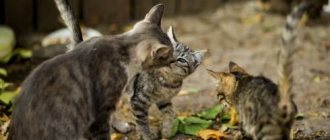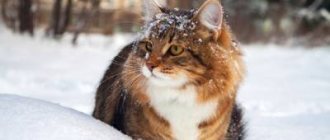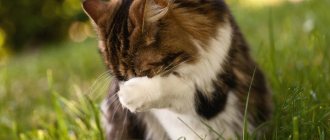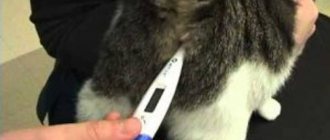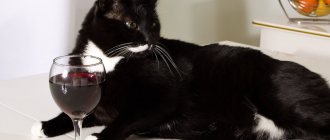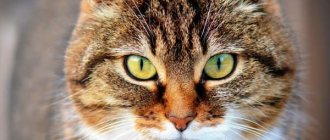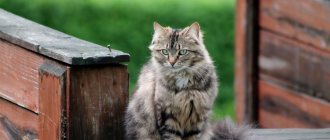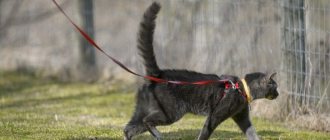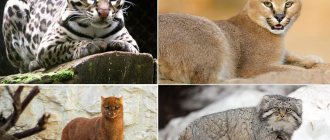For many centuries, including today, people have believed that cats see ghosts and ghosts. This is often due to unusual behavior of pets, which is difficult to explain otherwise. But are hard-to-explain events some kind of magic, and can cats really see ghosts?
Experiments by Luciano Boccone
Wait a minute to swear, romantically minded people!
Of course, cats are absolutely divine animals, and therefore there is a lot of mysticism and the otherworldly in scientific circles. In particular, back in the 80s, the Italian research scientist Luciano Boccone gathered a whole team of enthusiasts and built a laboratory on a hill near Arenzano, about the mystical properties of which the residents of the surrounding villages composed entire legends. Using a large amount of photographic equipment filled with infrared film, as well as sound recording and geophysical instruments, he and his fellow scientists for three years, several hours a day, recorded readings from those places and at the time where and when cats began to behave strangely , including looking into space and being afraid of something invisible to the human eye. Underground bunker - shelter concept for the next global crisis
Twitter and JPMorgan remove master, slave and blacklist from their code
We filled the countertop with primer and epoxy: friends are delighted with this gift
Luciano Boccone obtained truly stunning results: in the vast majority of cases, in the resulting images one could see certain entities whose nature was completely unknown to science. With their outlines and shape, they looked like ghosts and even some kind of fantastic animals, and their sizes could vary from a small coin to an entire stadium.
Impressive, isn't it? And this is by no means REN TV.
Other signs
The most interesting thing is that the cat does not even realize that its manners, gestures and behavior play such a role in the life of the owner. Still, a cat is an animal; it has the natural instincts necessary to survive in the wild.
Therefore, some of her habits can tell us about the weather and other phenomena:
- The nose is hidden under the paw for a reason; it’s getting colder;
- Before warming, the animal sleeps with its belly up;
- If a cat hides in a blanket or sleeps under a radiator, a cold snap is imminent;
- Scratches the floor - indicates windy weather;
- Constantly lies down on one place with the owner: stomach, chest, legs - expect illness here;
- pesters a pregnant woman - labor will begin soon;
It is believed that cats sense human energy. If an animal is affectionate towards guests: asking to be held, cuddled to their feet, then they came with good intentions. If he runs away from them or hisses, expect a catch.
The mustachioed friend is an assistant in literally everything. But to see signs in his every movement is to doom yourself to a restless life. Love your pets, treat them with full responsibility, then they will give you affection, joy, comfort, keep you company and you won’t care what cats see: ghosts or brownies, because they are already a member of your family and a friend.
Video: What can cats see?
In this video, Alexey Trekhlebov will tell you what cats can see that people cannot:
https://youtube.com/watch?v=5DU1M2388Rc
Fluffy Ghost Smokey
In May 1912, the Society for Physical Research published a terrible story. An elderly woman had a beautiful Persian cat, Smokey. One day she was severely mutilated by a dog - the animal’s ribs and paws were damaged. Death was painful and long - the cat was in severe pain. The woman's gardener buried the animal's corpse not far from the house.
3 weeks have passed since the funeral. Smokey's owner and her sister were having breakfast in the living room when they saw the cat calmly strolling across the lawn. She looked shabby - her fur was matted, and Smokey herself limped badly. The women could not be mistaken - this was their favorite cat.
They ran out into the yard and tried to catch the animal to give it milk, but to no avail - after a couple of minutes, Smokey disappeared without a trace. The frustrated gardener listened to the frightened women's story and even dug up the animal's grave to convince them that the pet was dead. From that moment on, no one ever saw Smokey again.
There are many other stories from owners of deceased cats. All eyewitnesses say that they were very homesick for their pets, and soon saw ghosts. Apparently, this is how the four-legged cats wanted to calm their owners and say goodbye to them. The ghosts appeared once or twice and then disappeared forever.
Why do cats return to earth as ghosts? Perhaps they want to warn people about danger? Or do they miss their owner so much that even death cannot prevent them from meeting their loved one? Alas, we will not know the answer to this question. These cases cannot be verified or explained, but also refuted. We can only guess...
If similar stories have happened to you or someone you know, please share with us!
Can dogs see the souls of dead people?
The fact that cats are directly related to the world of the dead has been known since ancient times, but do dogs see the souls of the dead?
In the myths and legends of different peoples of the world you can see images of dogs protecting people from evil spirits. Legends are legends, but in reality things are a little different. Dogs really have a relationship with the other world, but in a different way. We can say that they do not see, but feel the presence of entities.
The situation is different with so-called “four-eyed” dogs. These are dogs that have spots above their eyes. It is believed that such an animal never sleeps, because while both of its eyes are closed, the “eye spots” monitor what is happening around. This color feature does not belong to the breed, and having such a pet is considered a good sign. He will be devoted to his owner and not a single evil spirit will come close to the house in which the “four-eyed” dog lives.
Vision in the dark
Pets do not have perfect vision in the dark. In such conditions, some amount of light is still required. Animals can distinguish objects in minimal lighting. Cats need 10 times less light than humans.
Complete darkness for humans appears as twilight for pets.
The sensitivity of pets to the light flux is explained by the presence of a film inside the eye; it reflects it, so the rays are not scattered, but are completely deposited on the retina. Because of this, for normal vision of the environment, pets need 10 times less light than people. The main factors due to which cats and kittens can see a person in the dark:
- pets only need 10% of the light that people need;
- animals have an ellipsoidal eye shape;
- the organ of vision has 6 times more rods, which perform the function of night vision;
- There is a special layer behind the retina that helps collect and reflect rays;
- The cornea occupies most of the eye.
Important! The membrane located at the back of the organ of vision is capable of capturing even the smallest ray of light. In the dark, pets need to see more light, so the pupils, which look like vertical stripes in daylight, enlarge to almost the full size of the eyes.
This helps pick up any glare in the environment. When light is reflected, the tapetum membrane causes the cat's eyes to shine. The membrane has the ability to multiply the amount of flow up to 50 times
In the dark, pets need to see more light, so the pupils, which look like vertical stripes in daylight, enlarge to almost the full size of the eyes. This helps pick up any glare in the environment. When light is reflected, the tapetum membrane causes the cat's eyes to shine. The membrane has the ability to multiply the amount of flow up to 50 times.
Most pets' eyes emit a bright green color.
But the eyes of Siamese species often glow with bright yellow lights. The shade varies depending on the breed of the animal, the amount of zinc and riboflavin that are present in the cells of the tapetum. Membrane activity gradually decreases in cats. The lens becomes denser, and the organs do not reflect light as before. Also, the intensity of the glow is reduced by various pathologies - glaucoma, cataracts.
Research conducted to study the vision of cats has confirmed the fact that vision differs during the day and at night. Due to the sensitivity of the retina to brightness, cats have difficulty seeing during the day. From the moment darkness sets in, the eyes become sharper.
Note! If a cat's eyes do not glow in the dark, this indicates pathological processes occurring in the animal's body. This may be an injury, a disease in which the lens cannot perform its function
Also, the lack of taurine, which is obtained externally from food, leads to various types of vision deviations.
The article presented many discoveries, thanks to which it became known that the cat sees the world in color, and not, as previously believed, in black and white. She does not have a monocular organ, but a binocular one. At the same time, she distinguishes between certain colors. Her organ of vision has many features: an elongated pupil, which narrows in daylight and expands at night, and the presence of a third eyelid, designed to protect the membrane. Thus, a cat’s eyes are responsible for many functions in the body. Failure in their work indicates many ailments that need to be controlled.
https://catmolly.com/kak-vidyat-koshki/https://kot-pes.com/kak-vidyat-koshki/https://gafki.ru/koshki/kak-vidyat.html
Unusual cat pupils
Cats are nocturnal animals. They see at night 6 times better than us. This opportunity is given to them by a “mirror” located on the wall of the retina. The light absorbed by the pupil, which is significantly dilated at night, hits the “mirror” and is reflected and transmitted to the nerve fibers. This is how cats get a high-quality night picture. It is because of these reflective abilities that the animal's eyes glow in night photographs.
A person does not have such an opportunity, but during the day we see better. Since daylight is bright, the predator’s pupil turns into a narrow strip so as not to damage the sensitive retina and the animal distinguishes objects blurry.
The vision features of cats have always attracted attention. Not only from a scientific point of view. Their ability to see what is invisible to us has created many myths, legends, and horror stories, which we will discuss below.
Despite this, in Rus' these animals were considered an expensive gift: cats saved the harvest from rodents, served as a symbol of well-being, and protected the house from otherworldly forces. They became the heroes of many fairy tales, nursery rhymes and proverbs.
This video records a case where a cat clearly saw a brownie, look at her reaction:
Do cats see ghosts?
It has long been known that our smaller brothers are more susceptible, compared to people, to natural phenomena. The supernatural abilities of pets allow them to sense the approach of natural disasters, changes in weather, and relieve pain. How many cases have there been when a cat warned its owner, for example, about an impending fire or bombing!
But is it true that cats see ghosts? Discussion of this issue has recently become truly an Internet trend. However, the topic of paranormal abilities of felines has a solid history.
Special vision
In many religious systems, these animals served as guides to the world of the dead or were companions of spirits and deities.
Since ancient times, the magical ability of cats to see not only ghosts, but also, in general, another world hidden from us by a layer of reality, was explained by the peculiarities of vision of these animals - the unique ability to see in the dark and the magical glow of their eyes. After all, an animal with such unusual vision cannot help but observe something irrational!
However, from a scientific point of view, this phenomenon is explained quite simply.
On the surface of a cat's eyes there are special photoreceptors, much larger in number than in humans - they are what allow the cat's eyes to see in the dark.
The glow is due to the presence of a special “reflector”, thanks to which the light is used with maximum benefit, and is not absorbed by the retina, as in humans.
In the Middle Ages, Christians perceived the cult of the cat as proof of its closeness to dark forces, so animals, especially black ones, began to be destroyed.
As a result, ideas about the peculiarities of a cat’s vision and the mystical nature of the “sacred animal” traditionally overlap one another. However, at some point even ardent skeptics who are directly related to science may believe that their cat saw a ghost.
Why do they think cats see ghosts?
All owners from time to time notice absurdities in the behavior of their pets. Some are inclined to explain the strangeness precisely by the fact that the cats saw a ghost. “Inappropriate” behavior of animals, when there seems to be no object of attention, manifests itself in the following:
- They arch their backs, snort, raise their tails straight up, and jump;
- look intently at one point without moving;
- they begin to hiss and run out of the room as fast as they can;
- they play happily with something, running around the room, but there is no toy in their paws;
- they get scared, look around or run away as if someone is chasing them;
- avoid a certain place in the house (corner, piece of furniture, etc.).
Are you familiar with such situations? Don’t rush to immediately look for reasons for cats’ behavior in the otherworldly realm. Modern science tends to explain the overwhelming number of such cases quite simply and logically.
Smell and hearing
If you are sure that your cat sees ghosts, what we categorically do not recommend doing is immediately contacting psychics. Remember that in addition to her unusual vision, she has very acute hearing.
When hunting for mice, a cat relies primarily on sounds from the movements of its intended prey. The human ear is unable to detect this faint sound, but in our smaller brothers the hunting instinct is triggered.
The third explanation for the “strange” actions of felines lies in their character. Even adults are prone to games and the desire to have fun in those moments when it becomes boring. Therefore, jumping, snorting, hissing, etc. may be just a game element.
Unexplained cat behavior
Today everything is clear with the cat’s ability to see in the dark, as well as with its glowing eyes. Scientists have long found explanations for these phenomena, as it seemed before, ghosts have absolutely nothing to do with it. However, something in the behavior of cats still seems mysterious. Surely, every owner notices from time to time that:
- the cat sits for a long time and looks at one point, like an idol (as if it really sees something that others do not see - for example, ghosts);
- the animal suddenly breaks down and jumps out of the room, as if stung, although there are no obvious reasons for such behavior;
- the cat plays with something invisible for a long time, rushes around the house, has fun and it is clear that she has company (perhaps some kind of energetic entity, which can be attributed to ghosts);
- the pet stubbornly avoids some corner of the room, and if you try to bring it there, it begins to get nervous, hiss and struggle;
- the cat at one moment becomes frightened (fur on end, tail like a pipe), although in the visible space there is nothing visible that could frighten him.
Of course, observing such behavior, willy-nilly you will begin to wonder if the cat sees ghosts? Perhaps the Egyptians and other peoples were right when they considered this animal special, unearthly. Scientists have their own point of view.
Why are cats dangerous?
Furballs can cause trouble. First of all, these are dangerous diseases: rabies, helminthiasis, lichen, toxoplasmosis. They can be transmitted to humans in certain cases, some of them are deadly.
In terms of energy, well-being in the home, and good luck, animals sometimes bring trouble, as evidenced by the following beliefs:
- Drowning kittens means a dead person will appear in the family;
- Killing a cat, even a sick one, means endless trouble;
- If you drive away a cat that has come into the house, there will be no luck for 7 years;
- Dousing an animal with water means you won’t live to old age;
- Hit an animal - go to jail;
Thus, the cute animal can cause trouble. Believe this, do not have an animal at home.
Other superstitions associated with cats
If you take a pet into your home in order to protect it, or want to get a reliable guard against diseases, troubles and ill-wishers, choose the right kitten.
In Rus', animals were selected according to the color of the owner's hair. Now experts recommend relying on the color of the animal itself, depending on the following characteristics
:
- Redhead
is a solar messenger. Such a kitten will bring health to children and wealth to parents; - White
- will cleanse the house of negative energy, help fight serious illnesses, and relieve physical stress; - Gray
- will bring long-awaited love, restore understanding to the family, strengthen relationships; - Black
is a strong protector, will save you from family curses, remove the evil eye, drive away ill-wishers from the house, reward the owners with wisdom; - Siamese Tan
- attracts wealth, honor, respect; - Tricolors
are a symbol of longevity; - Two-colored
- imparts common sense and wisdom.
When you bring a kitten into the house, pay attention: he does not sleep, does not play, refuses to eat, which means he is not welcome. It’s better to return the baby back, take another one, he will be of little help.
How cats react to ghosts
Many stories from owners of meowing pets confirm the unusual behavior of their pets. One version of this is explained by the ability of cats to see ghosts. In such situations, the animal sits motionless, looking at the wall, ceiling, and the pet can remain in this state for a long time, without reacting to external stimuli (touch, toys, sounds). Some pets arch their backs and hiss into space, as if meeting someone dangerous, while they may try to hide and meow anxiously. Some pets exhibit different behavior: the animals seem to be playing with someone invisible, purring and arching their backs, as if someone was stroking them.
There are people in the world endowed with the ability to see another world, predict the future, they have access to the world beyond the limits of physical perception. Maybe cats, for the most part, have an innate ability to see the otherworldly.
Do cats see ghosts or not? In fact, the answer to the question depends not so much on the cat, but on your belief in ghosts and the supernatural. But first things first.
What allows cats to see ghosts?
If we assume that ghosts/brownies/poltergeists, etc. exist, then cats definitely have all the makings to establish a connection with them.
Extrasensory perception, translated into Russian, is supersensitivity. If we take this term literally, then cats, of course, are born psychics; their senses are developed much better than human ones, and even much better than similar organs in many other animals.
A cat hears sound waves from 45 to 65,000 Hz, distinguishes sounds in a range of 10 octaves, with a difference of 0.1 tones. At a distance of up to 3 meters, a cat is able to determine the location of its source with an accuracy of a centimeter. Thus, these animals distinguish between infra- and ultrasound, and hear sounds at a considerable distance. Therefore, the strange reaction of a cat, which is sometimes mistaken for a reaction to the presence of a ghost, may be dictated by the appearance of an unusual sound that is inaudible to our ears. On the other hand, these can be truly otherworldly sounds.
In addition to hearing, cats also have a very developed sense of touch. In fact, we can't even begin to imagine how a cat's sense of touch works, because not only is it significantly different from ours, but it is actually a completely different sense. Thanks to sensitive hairs (vibrissae), cats pick up the slightest vibrations in the air, and by analyzing this information they create a three-dimensional map of the area in their heads, similar to what we see with our eyes. Any “ghost” is a distortion of space, which will inevitably be recorded by the sensitive apparatus of the cat’s sense of touch. But this device can also detect a draft or slight movement of furniture.
A cat's vision is somewhat worse than a human's; they hardly distinguish colors, they see poorly both near and far (they see optimally at 1-6 m). Although they have a wider field of vision and better peripheral vision, the main thing is that they see ultraviolet light, because this is how their marks glow in the dark. It is unknown whether ghosts glow in the same way as cat urine, but cats' vision is also extrasensory.
Another interesting fact is that the pineal gland of cats contains the largest number of neurons of any vertebrate. This body, also called the “epiphysis,” is located in the midbrain and generates hormones and hormone-like substances, in particular melatonin, which is responsible for sleep and wakefulness. Perhaps the pineal gland in cats is so “saturated” due to the fact that they sleep a lot and are nocturnal, or perhaps this feature speaks of their extrasensory abilities. After all, medieval scientists called the pineal gland the “third eye” and the “seat of the soul.”
Is your cat sleeping peacefully by the window, and then suddenly jumps up and starts looking at the ceiling, as if a bird had flown into the window? But no matter how hard you try, you can't see anything that could be in the room!?
Or your kitten will suddenly hide and stare at the wall for a minute, as if his favorite scene from the movie (The Lion King) is playing there!
And again, no matter how hard you try to see something on the wall, you find nothing there: after all, there is nothing there that could attract his attention
Many people claim that cats have a very subtle sense that allows them to see ghosts or spirits
. But, before concluding that your pet is communicating with Casper, let's look at how cats' perception works and what they actually see.
The structure of the organs of vision
The cat's eye consists of 3 shells, each of which performs unique functions in detecting and perceiving light - the visible part of electromagnetic radiation. The general diagram of the structure is shown in the photo.
- The fibrous membrane is the outer layer of the eye, formed from collagen fibers and the protein elastin. It consists of the sclera, which covers 3/4 of the ocular surface area, and the anterior visible part, the transparent cornea, which covers the remaining quarter. The latter is responsible for receiving light and transmitting it to the inside of the eye for subsequent processing.
- The choroid is the middle layer with microscopic blood vessels that supply the eye tissue with nutrients and oxygen. In front of it is the ciliary (ciliary) body, with the help of the muscles of which the eye lens is held in the required position and its shape changes taking into account the distance to the object in question in order to ensure a clearer vision of it (the so-called accommodation process).
In front of the ciliary body is the iris, the colored part of the eye that divides it into outer and inner chambers. Its color depends on the presence of pigment and can be finally formed from 1 month of life to 2 years of age. In the center of the iris there is a black pupil, which changes its size with changes in the level of illumination to regulate the intensity of the light flux entering the eyes: it narrows in bright light, and in gloomy light it expands to let in maximum light.
The retina (retina) is the inner layer formed of light-sensitive cells that are responsible for converting light into nerve impulses for subsequent transmission to the brain using the optic nerve. Cats, like humans, have two types of photoreceptors:
- rods - provide light reception, pass it through themselves, which forms vision;
- Cones - responsible for image clarity, the ability to see small details and color perception.
It is with the predominance of rods in the retina in cats that their better vision compared to humans in low light is associated, which is necessary for them as animals that are nocturnal. In other respects, the structure of the eyes, as well as the mechanism of their operation, are practically the same.
Near the entrance of the optic nerve from the retina there is an area that is not sensitive to light - the “blind spot”. Photosensitive receptors are completely absent here, so information about the outside world that comes here is simply not perceived. But immediately behind it there is a “yellow body” in the form of a disk - the area of best vision, in which all the light entering the eye is focused. Therefore, animals turn their heads so that the rays end up on this particular part of the retina.
Ghosts and goblins
While watching your pet, you sometimes notice how his gaze suddenly turns into emptiness. For example, in an empty corner, on a sofa, on a windowsill. She looks as if someone is sitting there. The animal can suddenly jump into this place and meow.
- Do not scare the animal, follow further;
- The animal quickly calmed down, everything was fine, there was no danger;
- The animal continues to be nervous, which means the area needs to be treated;
- Read the prayer, sprinkle it with holy water, put an icon there.
Such advice is given by superstitious people. However, do not forget about the special sensitivity of these creatures. Perhaps she just hears what is happening behind the wall, so she reacts in a similar way.
History of the Cheshire Cat
Did you know that the famous Cheshire Cat is not just an invention of Lewis Carroll? The writer actually saw the dead animal.
The ghost first appeared at the beginning of the 20th century in the ruins of an ancient English abbey. During his lifetime, he was the favorite of the caretaker of the house, Mrs. Winge. One day the animal did not return home. After several days of futile searches, the woman realized that her pet was no longer alive. Imagine her surprise and horror when the cat appeared on the threshold of the abbey and began to scratch at the door! At first she thought that the pet just went on a spree and returned home. But the cat categorically refused to enter the house, and a minute later simply disappeared into thin air.
The striped, smiling hero of children's fairy tales and many cartoons is the most famous ghost in the world. He was seen by several hundred people who specially came to the abbey to see the ghost with their own eyes! Quote from an eyewitness: “the animal disappeared slowly, starting with the tip of its tail and ending with a smile that remained when the cat itself was no longer there.” No wonder they say: “A fairy tale is a lie, but there is a hint in it...”
Photo source
How many frames per second can a cat recognize?
Many owners claim that their cats love to watch TV, preferring channels about animals. Small predators freeze at the sight of their wild counterparts, closely follow the flight of birds, and sometimes try to pick them up with their paws. Whether our pets are really watching what is happening on the monitor at this moment or are they attracted by sounds and flickering is an open question.
Video: a film for cats starring birds
The global standard for filming is 24 frames per second, while the mustachioed stripes perceive up to fifty. Therefore, many scientists believe that cats see a set of slides on the screen, i.e., dynamic scenes seem intermittent to them. However, nature films that show 60 frames per second (60 fps) are already available on the Internet. They are the ones who are able to please our pets with a clear, smooth and realistic image.
I never noticed that my Manya was interested in TV, but for fun I decided to show her a cat video. For some time she watched the fussy movements of birds and rodents and even waved the tip of her tail. I was glad and waited for her to start squeaking pitifully and chattering her teeth, as she always does when she sees living birds. Alas, this did not happen. Literally a minute later, Manya turned away and yawned eloquently.
Ghost and cat
The ghost seen by the cat was in a room lit by fire from the fireplace. The cat lay with its head on the hand of its young mistress. She was sleepy and purring. Suddenly her purring became unusually restless. Despite all the efforts of the owner, who calmed her down, the animal broke out with rage. Looking up, the young woman experienced real horror: a small, disgusting, wrinkled old woman, occupying a chair in the opposite corner of the fireplace, leaned forward and gazed at her mistress. Her eyes seemed motionless and shining.
The cat, after some desperate efforts, ran away from its owner, jumped over tables and chairs and everything that was in its path, and began to rush in different directions. At the sight of the two closed doors of the room, the animal became more and more insane every moment.
The hostess took a breath and screamed. Suddenly her mother ran in, and the cat, at the sight of the open door, literally slipped through it and ran up and down the stairs for half an hour, as if someone was chasing her.
What does a cat see in the mirror?
Of course, cats see their own reflection in the mirror, but they do not recognize themselves. The first reaction will depend on temperament: some will want to play with the uninvited guest, others will boldly go into battle, and others will cowardly retreat. But interest and wariness quickly pass, since the animal’s sense of smell and hearing do not provide any additional information about the mysterious stranger.
In ancient times, superstitious people explained the negative reaction of a cat to a mirror by the fact that it sees otherworldly entities in it. In fact, the animal is trying to protect its possessions from the encroachments of the “alien”, who stares straight ahead and arches his back threateningly, therefore posing a challenge.
My cat has never shown any abnormal activity when looking at a mirror. At the first meeting, she only thoroughly sniffed the surface from all sides and immediately forgot about the existence of this object. The creature that Manya saw in the reflection did not impress her at all. Live cats are a completely different matter. From the very first moments, with a guttural growl, she delicately asks them to stay away from her.
Who lives in the corner?
Lidia Pavlovna Semenikhina from the city of Dnepropetrovsk has a parrot named Kesha. He does not speak by imitating people, but constantly chatters in an incomprehensible language. Immediately after Kesha was bought, he was placed in the room where Lydia Pavlovna’s old, paralyzed mother lay, so that she would not feel lonely when the household went to work. Kesha probably liked this neighborhood. When someone entered the room, he began to beat his wings and squeal, as if expressing dissatisfaction with the intrusion of strangers. Mother died. Kesha was missed. At first he sat with a ruffled face and was silent, then he suddenly took a dislike to the far left corner. Something scared him there: Kesha looked there, screamed and even rolled his eyes in fear. However, the parrot did not want to move out of its mother’s room. As soon as his cage was moved to another room, he began to rush around and make noise. Returned to his original place, Kesha immediately calmed down until he turned his gaze to the left corner of the room. Lydia Pavlovna pulled a rope in the corner and hung a sheet on it. Kesha calmed down. The experiment was repeated. And again - the same result. Deciding that some object was frightening the bird, they removed all the furniture from the left corner, but the parrot continued to worry. It was assumed that Kesha saw something terrible on the wallpaper, the design of which was shifted in this place. The wallpaper was re-pasted, but that didn't help either. To somehow distract the parrot, they bought him a girlfriend, but she also began to behave like Kesha. I had to block both sides of the cage with paper so that the parrots could not see the unfortunate corner. The birds immediately stopped worrying. For unknown reasons, they refused to move out of their room. What is hiding in the left corner of the old woman’s room and why do parrots see it, but people don’t notice?
Mystical abilities of cats
Magicians and psychics are sure that cats are guardians who stand on the border of the astral world and the real one. If a portal to the astral plane opens, clots of negative energy, ghosts, and demons can come out of it. According to legends, it is the guests from the other world that the cat senses, which is why at times it becomes aggressive and wary. In addition, cats have developed intuition, which helps the pet “predict” earthquakes, fires, and floods. Anticipating a catastrophe, the cat tries to get away from the unfavorable place in advance.
Traditional healers and mediums are confident that a pet senses the owner’s illness, even if the illness has not yet manifested itself with pronounced symptoms. At this time, the “dirty” energy of the disease emanates from the diseased organ, which helps the cat identify the location of the pathological process and heal it with its healing energy. The animal simply comes and lies on the unhealthy organ, begins to purr, getting into a special resonance with the owner’s body, and healing occurs. The cat also relieves tension and stress of the owner, cleanses him of negative energy. People who wish harm to the owner do not tolerate the presence of his cat next to them.
Historical reference
Cats have always been distinguished by their independence. It turned out to be not so easy to tame them, unlike, for example, dogs. When this finally happened, and the cat entered the man’s house, she still behaved in a special way, demonstrating her love for freedom at every step.
shutterstock
She did not fetch a stick like a faithful dog, did not wag her tail, begging for food, but walked on her own, wherever and with whomever she wanted. Of course, such behavior alarmed a person who thought that there was some kind of secret in this animal, something unknown and mystical.
The ancient Egyptians, who were the first to domesticate the cat, made a huge contribution to the creation of the cat’s special reputation. Having lured the fluffy beauty out of the wild for the sole purpose of catching mice, the inhabitants of the land of the pyramids soon began to endow the animal with miraculous abilities and worship it, considering it almost a deity. Ancient Egyptian figurines in the form of cats or pictures with her image are still found. How these animals were treated:
- People, accustomed to explain any natural phenomena as something supernatural, considered the ability of a cat to see in the dark to be a gift from the gods or evil spirits (ghosts or Satan himself).
- Also, a person was haunted for a long time by the glowing eyes of the animal, which plunged some into horror, and made others fall on their faces.
- During the Middle Ages, when Christianity was firmly rooted in Europe and the church pursued an aggressive policy, the cat was recorded as an accomplice of the devil precisely because of these properties. People massacred tailed fluffies: they hung them on poles and publicly burned them.
The Egyptians and medieval Europeans believed that cats could see ghosts. Only the former treated the animal with respect, while the latter killed it. I wonder what gives modern people, armed to the teeth with scientific discoveries, the basis to attribute some kind of supernatural abilities to cats, including communication with ghosts?
shutterstock
The structure of a cat's eyes
The vision of all mammals is the same. The pupil transmits light through the lens onto the retina, forming an inverted image there. The retina transmits a signal through the optic nerves to the part of the brain responsible for visual perception. The brain flips the image and forms the real picture.
But there are still differences in the perception of the world. They are determined by the structure of the eyes and evolution.
Features of cat's eyes and the influence of anatomy on vision.
- Proportions of eyes and body. Compared to humans, cats have huge eyes. If we correlate the proportions of the body and eyes, then people's eyes would be the size of a large orange. Therefore, the lens of a cat’s eyes is larger, and so is the field of view. Human vision spans 180, versus a cat's 200 degrees. But the zone of peripheral vision, in which objects are clearly visible, is larger in humans. Focusing is also determined by the size of the eyes. People see everything in front of them quite sharply. Cats focus only on individual objects, the rest of the picture is blurred and they do not pay attention to it.
- Elasticity and size of the lens. In humans, the lens is softer and smaller. Therefore people see more clearly. A person is able to examine objects in detail at a distance from 5 centimeters to 50 - 60 meters. Eyes with a large and hard lens see better in the dark and focus well on prey a meter away from the hunter. But, at a distance closer than 60 centimeters and further than 6 meters, cats’ vision is worse than that of humans. They don't see far or close very well. Therefore, sometimes they have to be pushed closer to the food until they feel it with their nose.
- Pupil shape and size. The main difference is the slits in cats and the round pupils in humans. Cat slits act faster, slightly compensating for the stiffness of the lens. Due to its specific shape, in the dark the pupil occupies up to 90% of the eye, and in bright light it becomes barely noticeable. This helps you see well at dusk and protects your cat's eye in the sun.
- The retina is made up of nerve endings called cones and rods. Rods are responsible for the perception of light, cones are responsible for color perception. The ratio of rods to cones in humans is four to one, in cats it is twenty-five to one. Thanks to this, humans can better distinguish colors, and cats can see well in the dark. Also, sticks help cats hunt; they respond well to quick movements.
- Fascinating and frightening fairy-tale sparkle of eyes in the dark. Possible due to another difference. Behind the retina in cats is a tapetum lucidum or light curtain. Light, reflected from it, hits the retina a second time. The cat sees well in the dark, but does not shine, but simply sparkles with its eyes.
Evolutionary rationale
The eternal story of catching up with cat and mouse. Rodents try to become invisible, run away and hide. Cats track, chase, search. All this happens at night and this routine has been established for a long time. During this time, the rodents became gray-brown, almost invisible at night.
Cats have learned to distinguish 25 shades of gray and see mice at night. Cats do not see the world as colorful as humans, but at dusk they can easily distinguish a gray rodent against a gray background. So at night, with poor lighting, cats see the world in black and white, or, more precisely, in black and gray. Evolution has done its job - if you want to eat, learn to see. Cats are well adapted to see in the dark and also react quickly to movement. Thanks to this, they became successful hunters.
This is interesting: A cat with a flattened muzzle and big eyes
Another opinion
Despite the fact that a scientific basis has been found for most of the cat’s oddities, people still cannot clearly explain some things. That's why thoughts about ghosts creep in.
Many true stories testify to a cat’s ability to sense and see the dead. For example, one elderly woman had a cat for a long time, and then this lady died, and children and grandchildren moved into her house. Time passed, and relatives began to notice that every year on the day of the old woman’s death, the pet sits at the door of her room and stares at one point for a long, long time.
Many people are simply sure that cats communicate with the dead, because they notice: in the first days after the death of a person, you literally cannot kick the animal out of the room where he lived and died. Despite the fact that before this it could almost never appear there. Although, according to the Christian religion, the soul does not immediately leave the earth.
People don’t see her, but cats feel the presence of a ghost and communicate with him in some special, unknown language. You can also recall the ability of fluffies to anticipate various disasters: fires, hurricanes, earthquakes. There are many real cases recorded around the world where cats managed to warn their owners about danger and save them.
Scientists explain this again by the good functioning of the senses. They say cats simply hear the roar of an approaching hurricane, or smell the smell of wiring that has begun to smolder long before the fire. However, many people believe that these are ghosts, caring for their loved ones, transmitting information to them through animals.
Everyone has the right to think as they want. Cats are actually very difficult. Most likely, the question of whether they see ghosts will remain open for many, many years.
Cats are intelligent creatures that hear, see, feel more than humans; they are able to communicate with each other without using sounds, understand a person’s mood, and even heal. The strange behavior of pets sometimes frightens owners. Thoughts immediately arise about the connection between cats and the other world. How to explain the animal’s gaze directed into nowhere, hissing into the void, playing with something invisible?
In Ancient Egypt, cats were considered sacred creatures, they were deified, and after death they were mummified and kept in mourning. They were believed to be guides to the other world and protectors from evil spirits. But can modern cats see ghosts?
Countless facts from history confirm that at all times people have seen a special connection between cats and the spiritual world. According to psychics, these animals see deceased relatives and are able to warn the owner about evil spirits entering the house.
On the one hand, skeptics will not allow the thought of this ability of cats, but on the other hand, psychics and ordinary people who are confident that cats with supernatural abilities can see ghosts. Of course, the existence of ghosts has not been proven, but the opposite has not been proven either. There are several features of animals that will help you understand this issue.
Scientific evidence behind cat oddities
So, do cats have supernatural powers? Scientists say yes. However, they are supernatural only for us, and for many animals they are the norm. First of all, we are talking about :
- hearing;
- smell.
© shutterstock
Cats are actually able to hear sounds and smell much better than humans. After all, they once lived in the wild, and no one brought them food on a plate. To hunt, you had to have good ears and nose.
Therefore, when a cat sits motionless for a long time and it seems to us that she sees a ghost, the animal simply listens to the rustling of a mouse somewhere in the basement or attic. If he suddenly takes off and runs somewhere, perhaps it is just a chase after game, the smell of which has reached the sensitive nose of the furry predator.
Mystical signs have absolutely nothing to do with it. At least so far, scientists have not found evidence of the ability to see them (as well as evidence of the existence of ghosts).
Scientific findings
Each of Professor Bozzano's conclusions is increasingly striking. They suggest that even if we want to show our consistency in the analysis of individual cases, we still must recognize that there are a large number of significant and indisputable facts that are difficult to question.
“From all of the above, it follows that the possibility of psychic perception in animals cannot be denied. And if, from the point of view of scientific research, humanity has a long way to go in order to consider the category of phenomena under consideration proven, then, on the other hand, we can without a doubt admit that the verdict of scientists cannot but be completely affirmative.”

